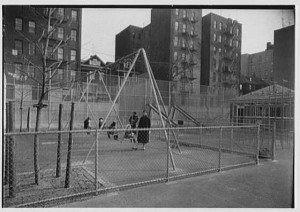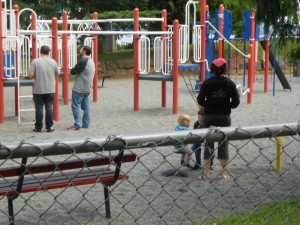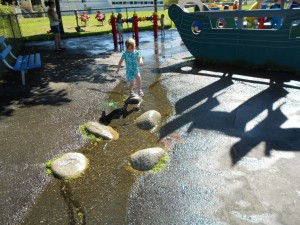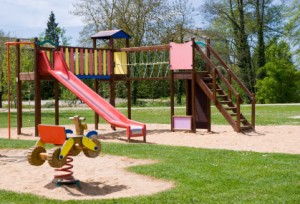 Kids and playgrounds seem like a natural combination but did you know that playgrounds are a relatively new invention? Although there were some before, in 1907 President Roosevelt stated “….since play is a fundamental need, playgrounds should be provided for every child as much as schools.” Check out this Library of Congress picture of a playground from 1955.
Kids and playgrounds seem like a natural combination but did you know that playgrounds are a relatively new invention? Although there were some before, in 1907 President Roosevelt stated “….since play is a fundamental need, playgrounds should be provided for every child as much as schools.” Check out this Library of Congress picture of a playground from 1955.
Besides providing a space for all kinds of movement activities, kids also interact with others using early social skills such as taking turns, waiting, sharing and making friends.  There’s math fun by counting and comparing, science fun seeing seasonal changes and small critters, imagining and pretending, certainly lots of language, learning about shapes and colors, patterns and rhythm, risk management, practicing safety, stretching beyond fears and hesitations, and gaining confidence. Best of all, these and other skills, are all learned as children play and explore. More than skills for kindergarten readiness, these are life skills.
There’s math fun by counting and comparing, science fun seeing seasonal changes and small critters, imagining and pretending, certainly lots of language, learning about shapes and colors, patterns and rhythm, risk management, practicing safety, stretching beyond fears and hesitations, and gaining confidence. Best of all, these and other skills, are all learned as children play and explore. More than skills for kindergarten readiness, these are life skills.
 Since the early days of playgrounds, there has certainly been more attention to how they can support children’s learning and development. In response, the equipment and designs of playgrounds have changed. Now there are adventure playgrounds, construction ones with loose-parts, neighborhood tot lots and many more. Playgrounds often include more natural materials and areas. Sandboxes are not as frequent as they used to be but now there are water parks. What can be more fun on a hot day than sprinklers and squirters going off in all directions? One problem though, the adults are usually pretending that they are getting wet by accident.
Since the early days of playgrounds, there has certainly been more attention to how they can support children’s learning and development. In response, the equipment and designs of playgrounds have changed. Now there are adventure playgrounds, construction ones with loose-parts, neighborhood tot lots and many more. Playgrounds often include more natural materials and areas. Sandboxes are not as frequent as they used to be but now there are water parks. What can be more fun on a hot day than sprinklers and squirters going off in all directions? One problem though, the adults are usually pretending that they are getting wet by accident.
 Playgrounds are more than spaces for kids. These play areas have a community function, bringing neighborhoods together. Often, groups will form to fund raise and even assemble playgrounds. In all of them, children can explore and discover and PLAY. Are there some playgrounds nearby and some space in the day for fun, learning, and playground PLAY?
Playgrounds are more than spaces for kids. These play areas have a community function, bringing neighborhoods together. Often, groups will form to fund raise and even assemble playgrounds. In all of them, children can explore and discover and PLAY. Are there some playgrounds nearby and some space in the day for fun, learning, and playground PLAY?
